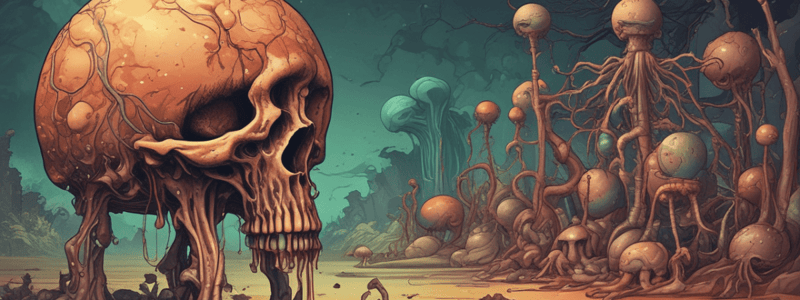Podcast
Questions and Answers
What is the primary structure protected by the meninges?
What is the primary structure protected by the meninges?
- Peripheral nervous system
- Brain and spinal cord (correct)
- Cerebrospinal fluid
- Sensory nerves
What is the primary causative agent of Tetanus?
What is the primary causative agent of Tetanus?
- Escherichia coli
- Clostridium botulinum
- Clostridium tetani (correct)
- Streptococcus pneumoniae
Which symptom is NOT an early manifestation of Tetanus?
Which symptom is NOT an early manifestation of Tetanus?
- Difficulty swallowing
- Lockjaw
- Stiffness in the neck
- Severe muscle contractions (correct)
Which type of meningitis is generally less severe and resolves without specific treatment?
Which type of meningitis is generally less severe and resolves without specific treatment?
How does the toxin produced by Clostridium tetani affect the nervous system?
How does the toxin produced by Clostridium tetani affect the nervous system?
Which of the following bacteria is a leading cause of bacterial meningitis today?
Which of the following bacteria is a leading cause of bacterial meningitis today?
What is a major symptom of bacterial meningitis in individuals over the age of 2?
What is a major symptom of bacterial meningitis in individuals over the age of 2?
What is the primary treatment for Tetanus?
What is the primary treatment for Tetanus?
What type of transmission is associated with Neisseria meningitidis?
What type of transmission is associated with Neisseria meningitidis?
What is the recommended prevention method for Tetanus?
What is the recommended prevention method for Tetanus?
What is the typical average number of botulism cases reported annually in the US?
What is the typical average number of botulism cases reported annually in the US?
Which symptom may indicate bacterial meningitis, based on common indicators?
Which symptom may indicate bacterial meningitis, based on common indicators?
What is the role of the blood-brain barrier?
What is the role of the blood-brain barrier?
What complication is associated with Tetanus, especially in those over 60 years old?
What complication is associated with Tetanus, especially in those over 60 years old?
Which layer of the meninges is the outermost?
Which layer of the meninges is the outermost?
Which vaccine is recommended in the USA for prevention of infections caused by N. meningitidis?
Which vaccine is recommended in the USA for prevention of infections caused by N. meningitidis?
What can be a consequence of untreated bacterial meningitis?
What can be a consequence of untreated bacterial meningitis?
Which of the following forms does botulism NOT occur in?
Which of the following forms does botulism NOT occur in?
Which of the following is NOT a common transmission method for bacterial meningitis?
Which of the following is NOT a common transmission method for bacterial meningitis?
What is the mechanism of action for the botulinum toxin?
What is the mechanism of action for the botulinum toxin?
Flashcards are hidden until you start studying
Study Notes
Structure and Function of the Nervous System
- Central Nervous System (CNS): Comprises the brain and spinal cord.
- Peripheral Nervous System (PNS): Includes nerves that branch from the CNS.
- Meninges: Protective layers surrounding the brain and spinal cord, consisting of three layers:
- Dura mater (outer)
- Arachnoid mater (middle)
- Pia mater (innermost)
- Subarachnoid space houses cerebrospinal fluid (CSF), which cushions the brain and spinal cord.
- Blood-brain barrier: A physiological barrier separating circulating blood from the brain, maintaining CNS homeostasis.
Meningitis
- Infection of CSF surrounding the brain and spinal cord, caused by bacteria and viruses.
- Viral meningitis: Typically less severe and often resolves without specific treatment.
- Bacterial meningitis: More severe, can lead to brain damage, hearing loss, or learning disabilities.
Bacterial Meningitis
- Causative agents:
- Historically, Haemophilus influenzae (HiB vaccine introduced).
- Current leaders: Streptococcus pneumoniae and Neisseria meningitidis.
- Transmission:
- Neisseria meningitidis: Direct person-to-person transmission in crowded environments (schools, military camps, prisons).
- H. influenzae and S. pneumoniae: Spread through respiratory droplets.
- Signs/Symptoms:
- Typical in individuals over 2 years old: High fever, headache, stiff neck, nausea, vomiting, photophobia, confusion, sleepiness.
- Progression may lead to seizures.
- Diagnosis & Treatment:
- Diagnosed via lumbar puncture (culturing CSF).
- Treated with antibiotics like penicillin, cefotaxime, and ceftriaxone.
- Prevention:
- Vaccines recommended for H. influenzae, certain N. meningitidis strains, and Streptococcus pneumoniae.
Tetanus
- Acute and often fatal disease characterized by muscular rigidity and convulsive spasms.
- Reported 37 cases in the U.S. in 2001.
- Causative agent: Clostridium tetani.
- Transmission: Usually occurs through puncture wounds, handling contaminated objects (e.g., bedpans, diapers).
- Mechanism: Tetanospasmin toxin from vegetative cells inhibits GABA release from inhibitory neurons, preventing muscle relaxation.
- Signs/Symptoms:
- Early: Lockjaw, neck and abdominal stiffness, difficulty swallowing.
- Later: Fever, heightened blood pressure, severe muscle contractions.
- Complications: Approximately 11% mortality, especially in individuals over 60.
- Treatment: Involves IV penicillin, tetanus IgG, and tetanus antitoxin.
- Prevention: DTaP vaccine, developed from inactivated toxin, significantly reduced tetanus incidence in the U.S.
Botulism
- Average of 110 annual cases in the U.S.
- Causative agent: Clostridium botulinum.
- Occurs in three forms: foodborne, infant, and wound botulism.
- Botulism is toxin-mediated, with the toxin blocking the release of acetylcholine, leading to paralysis.
- Notably, botulinum toxin is considered the most acutely lethal toxin known, with an L.D.50 lower than that of other toxins.
Studying That Suits You
Use AI to generate personalized quizzes and flashcards to suit your learning preferences.




